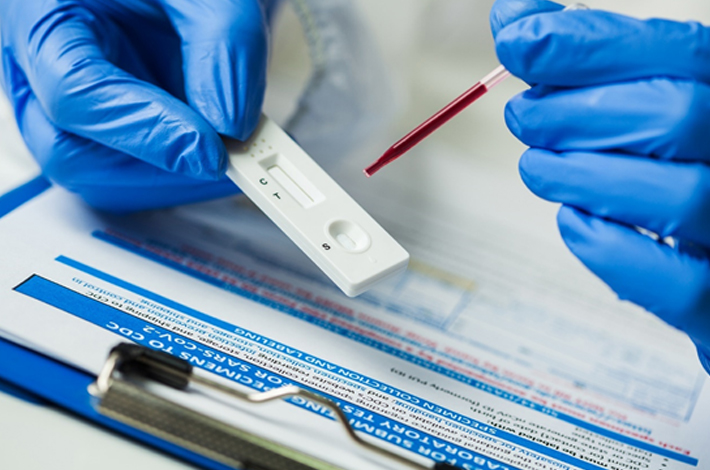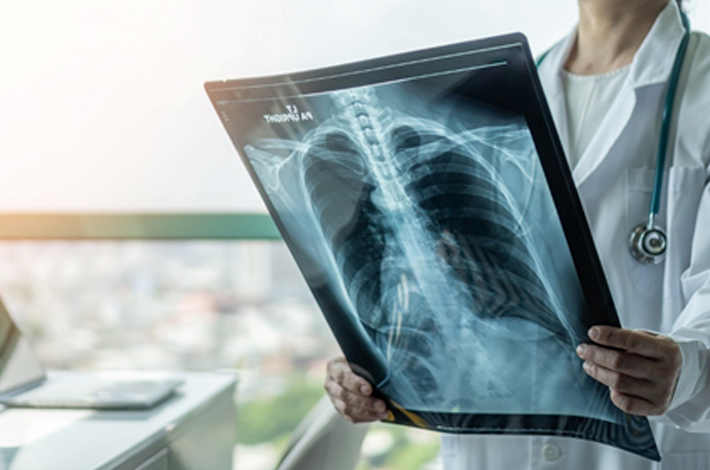29 April 2024
Spotlight
Diagnostics Industry Chugs on the Growth Path

The Indian In Vitro Diagnostics (IVD) industry, like in the rest of the world, saw unprecedented growth in the COVID years. Despite a slight post-pandemic deceleration, the industry seems poised for consistent growth over the next several years. Management consulting and knowledge services firm Praxis Global Alliance predicts a CAGR of 14% for this market in the next five years. Similarly, according to a study by the rating agency CRISIL, diagnostic companies look forward to a 10 to 11% growth in revenue in the financial year 2024-2025.

Mr Thomas John is the Managing Director of Agappe Diagnostics Ltd, one of India's fastest-growing IVD companies, catering to the vast domestic market as well as nearly 100 countries across the globe. Engineer-turned-entrepreneur, Mr John is also the president of the Association of Diagnostic Manufacturers of India (ADMI). We spoke to him on a wide range of topics related to the dynamic industry. Here are excerpts:
How is the Indian diagnostic industry faring? Is the COVID-era growth momentum still intact?
The Indian diagnostic industry has shown resilience and continued growth, even during the COVID-19 pandemic. With increased demand for COVID-19 testing and vaccination-related diagnostics, the industry experienced a surge in revenue. However, challenges such as supply chain disruptions and fluctuating demand for non-COVID diagnostics have impacted growth. Despite this, the industry remains optimistic, leveraging technology and innovation to adapt to changing market dynamics and meet evolving healthcare needs. Overall, while the COVID-era growth momentum may have moderated, the Indian diagnostic industry continues to demonstrate potential for sustained expansion and development.
Which segment of the diagnostic sector is poised for relatively faster growth?
The immunology segment of the diagnostic sector in India is poised for relatively faster growth. With a substantial market share of over 22% and significant growth potential, this segment is attracting attention due to factors such as limited competition, both pre-COVID and post-COVID scenarios. The market size is projected to increase from Rs 16,000 crores to Rs 32,000 crores in the next five years, with a robust compound annual growth rate (CAGR) of 14-15%. This growth is fuelled by increased demand for immunology diagnostics, driven by advancements in technology, rising awareness, and the growing prevalence of immune-related disorders.

Can you give us some idea about the share of pathology and radiology segments of the diagnostics market in India?
As per recent reports, the Indian diagnostics industry stands at an estimated value of Rs 67,500 crores. Within this sector, the Radiology segment comprises approximately 42% of the market, equivalent to Rs 28,400 crores, while the Pathology segment constitutes about 58%, amounting to Rs 39,200 crores.
Furthermore, the distribution of diagnostic services among referral centres, walk-in facilities, and corporate clients is as follows: 55% are referral centres, 35% are walk-in facilities, and 10% are corporate clients.
Urban areas account for 65% of the market share, with rural areas making up the remaining 35%. In terms of service providers, hospitals capture 37% of the market, standalone centres hold 47%, and diagnostic chains represent 16%.
India presents a stark contrast when it comes to IVD facilities. We have metros and other top-tier cities where diagnostic facilities are world-class, but the situation is different in smaller towns and rural areas. What is the industry doing to bridge this gap? Is this divide more visible in north India than in the south?
Disparity in diagnostic facilities between urban and rural India is a pressing issue. While metros excel in healthcare, smaller towns face challenges. Regional differences exist, with Kerala's robust system mitigating the gap.
Agappe addresses this by providing tailored solutions. Our Nephelometers, like MISPA I2 and MISPA I3, cater to rural labs, ensuring quality at affordable rates. Equipment such as Mispa CountX and Mispa Viva are well-suited for rural settings. By leveraging such technologies, Agappe aims to bridge the urban-rural healthcare divide, ensuring access for all. Collaborative efforts with stakeholders further this goal, promoting healthcare equity nationwide.
Accreditation of labs is a big issue as out of the estimated more than one lakh labs only a few hundred labs are accredited in India. Not even 20% of the diagnostic business in India is in the organised sector. Isn’t this in itself an impediment to sustained growth?
The limited accreditation of laboratories is a critical obstacle to the ongoing growth and development of India's diagnostic industry. Currently, only a small fraction of the estimated 100,000 labs are accredited, and less than 20% of the diagnostic business is conducted within the organized sector, presenting significant challenges that impede progress.
In terms of accreditation specifics, India has:
- Approximately 1,000 Class A labs,
- Between 4,000 and 5,000 Class B labs and among 6000 of these labs, only 2,500 currently hold accreditation from the National Accreditation Board for Testing and Calibration Laboratories (NABL). It’s crucial for us to establish a regulatory framework aimed at increasing this number by an additional 3,500 over the next five years, achieving NABL accreditation for around 6,000 labs. There is also potential for some Class C labs to achieve NABL accreditation with government support.
How do we compare with the developed countries on this front?
Countries like Germany and others across Europe maintain standards where 100% of operational labs are accredited, reflecting the high level of quality control in these developed nations.
India has fewer than 100 labs accredited by the College of American Pathologists (CAP), which represents a higher tier of recognition. In the context of hospital accreditations, fewer than 50 Indian hospitals have achieved Joint Commission International (JCI) accreditation, a standard that signifies the best practices and most rigorous benchmarks to enhance performance. Globally, over 23,000 healthcare organizations in more than 70 countries are accredited by JCI.
What should be done to improve the situation?
First of all, the benefits of accreditation should be popularised more vigorously. Accreditation enhances quality, consistency, and accuracy across the healthcare spectrum, leading to better overall health, wellness, and infrastructure. Accredited laboratories engender trust among patients, healthcare providers, and regulatory authorities, creating a supportive environment for growth and expansion.
Without such accreditation, the industry risks engaging in substandard practices, yielding unreliable test results, and compromising patient safety—factors that severely limit the sector's potential. Therefore, promoting accreditation through awareness campaigns, capacity-building initiatives, and incentivization schemes is vital to encourage more laboratories to undertake the accreditation process.

Pressures from new competitors such as online aggregators and hospital chains are making life difficult for those in the diagnostic sector. What measures is the industry taking to reduce this pain?
The diagnostic sector is responding to competition from online aggregators and hospital chains by leveraging technology, enhancing service offerings, and strengthening customer relationships. Many laboratories are investing in online platforms for appointment scheduling, result delivery, and teleconsultation, improving convenience for patients. Additionally, collaborations with healthcare providers and strategic partnerships enable labs to expand their reach and offer comprehensive services. Continuous innovation in test offerings, cost-effectiveness, and personalized care further differentiate traditional labs, mitigating the impact of new competitors and ensuring sustained relevance in the evolving healthcare landscape.
The cost of diagnostic tests is still a major concern for a large section of our population. Is the industry doing something about it?
The cost of the diagnostic kits from the domestic manufacturers is very much lower, but the same is passed to the final service providers, say labs or hospitals. But the cost difference at this service level is easily 5 to 10-fold compared to the manufacturer's price. This is the crux point in providing affordable diagnostics to poor Indians, where the majority of medical expenditure is out-of-pocket mode. So, there should be some consideration from the policymakers to address this price gap in this industry
Major players in IVD products catering to Indian markets are MNCs, and most of the products are imported from Europe, the US, and other developed countries. Naturally, the per-test cost of these tests will be higher. Hence, Indigenisation is the only means to bring down the cost of diagnostic services when it comes to the manufacturer. For example, Agappe has brought two marker Specific Protein Analyzers Mispa i2 and Mispa i3, both on Nephelometry platform which could bring the cost of machines down by 10 times. Besides, per test cost also could be brought down to fit into medium and small labs in the rural areas.
Many laboratories are adopting cost-effective technologies and optimizing operational efficiencies to reduce testing expenses without compromising quality. Additionally, strategic alliances with government health programs and insurance providers facilitate subsidized testing for economically disadvantaged populations.
Moreover, initiatives such as community outreach programmes, health camps, and mobile diagnostic units bring testing services closer to underserved communities at affordable rates. Through these measures, the industry is striving to make diagnostic tests more accessible and affordable, ensuring that cost is not a barrier to essential healthcare services for all segments of society.
Agappe Diagnostics Ltd is heavily into exports – which are the key markets for the industry?
Agappe, with 20% of its revenue generated from export sales, boasts a robust presence in nearly 100 countries. These markets include South East and South West Asia, Africa, SAARC nations, and the Middle East. By strategically targeting these regions, Agappe taps into a wide spectrum of healthcare systems, catering to the unique needs and demands of diverse populations.
What are the industry’s expectations from ADMI?
As ADMI is the only IVD association in India with a membership of 80 manufacturers, the industry looks to us for leadership, guidance and support. ADMI has been instrumental in ensuring clarity on rules, regulations, and policies governing the relatively younger sector. During COVID times, we constantly worked with the government departments concerned, seeking support for the industry and removing policy hurdles for smooth functioning in time of crisis. We want to work with the customers and engage in mapping customers and bringing their demands, requirements and expectations on one platform. Our focus is, of course, on the manufacturers as it is indigenisation that ensures quality advantage to the final customer.
Is the government's Make in India push helping the diagnostic manufacturers?
Yes, the government's Make in India initiative is proving beneficial for diagnostic manufacturers, including Agappe Diagnostics Ltd. The Atma Nirbhar Bharat concept aligns with our goals of self-reliance and indigenous manufacturing. Initiatives like the Production Linked Incentive (PLI) schemes provide tangible support, incentivizing domestic production and innovation in the medical devices sector.